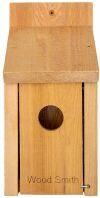
What’s This Post About?
Woodpeckers are strongly billed, pointed-tailed birds that are often found in dense forests and backyards too. They are fun little creatures and usually have a black-feathered body with splashes of white on it and a red-colored spot on their heads. Their color varies across different species.
If you are interested and eager to observe these quirky little birds in your backyard, you may invest in a feeder and place a seed mix in it for them to visit. To learn more about woodpeckers and their migratory pattern, keep reading.
Some woodpecker species are sedentary; they stay in the same region where they nest while other species migrate south during winters. Six of these species never migrate; Downy, Hairy, Red-bellied, and Pileated Woodpecker being among the most common ones to stay back in their preferred nesting regions.

What Do Woodpeckers Look Like?
Woodpeckers are pretty famous for having a strong bill and a pointed tail. Their coloration in plumage varies across species. Most woodpeckers have white patches on their black-feathered bodies and a red crest on top of their heads.

Familiar to the U.S, especially downy woodpecker, is one of the most commonly sighted backyard birds in North America. Their bills are strong and sturdy, which helps them dig up dead trees and other wooden surfaces.
| Common Name | Woodpecker |
|---|---|
| Scientific Name | Picidae |
| Diet | Berries, insects, nuts, and seeds from trees and shrubs |
| Average Lifespan | 4 – 12 years |
FUN FACT
There are about 180 species of woodpeckers worldwide.
How Many Woodpecker Species Are There?

There are over 180 different species of woodpeckers spread across the world, among which some of the known and well-researched are the following:
- Acorn Woodpecker
- Melanerpes formicivorus
- American Three-Toed Woodpecker
- Picoides dorsalis
- Arizona Woodpecker
- Picoides arizonae
- Black-back Woodpecker
- Picoides arcticus
- Downy Woodpecker
- Picoides pubescens
- Gila Woodpecker
- Melanerpes uropygialis
- Gilded Flicker
- Colaptes chrysoides
- Golden-fronted Woodpecker
- Melanerpes aurifrons
- Hairy Woodpecker
- Leuconotopicus villosus
- Ivory-billed Woodpecker
- Campephilus principalis
Woodpeckers and Their Migration Patterns
To better understand why some woodpecker species are seen year-round while others seem to disappear during wintertime, it is important to look into what different species’ migration pattern is like.
Migratory Woodpeckers
There are seven main migratory woodpecker species that are seen migrating.
1. Yellow-bellied Sapsucker

This is one of the most migratory species of woodpeckers which take off in fall and return to their nesting region in April, which is essentially their breeding period.
They are short as well as long-distance migrants that leave their breeding place for wintering grounds in the U.S, Central America, West Indies, and Mexico.
2. Northern Flicker

Northern Flickers are one of the few migratory woodpeckers of the North American Region that moves south in winters, whereas some of them stay farther up in the north.
3. Red-Headed Woodpecker

Red-headed woodpeckers are abundant in Central and Northern US states. They migrate south during April in spring and then in September in the fall. They migrate mainly because of food resources.
4. Lewis’s Woodpecker

They’re woodpeckers that migrate to the south-western states during winters. However, most of Lewis’s woodpeckers that are native to Texas and Arizona tend to stay in their home regions.
5. Red-Naped Woodpecker

These birds breed in the mountainous forests in the western U.S. states before they take off and migrate to southern parts of California, Arizona, and New Mexico for wintertime. They migrate during the spring specifically in the months of March and April.
6. Williamson’s Sapsucker

During summers, Williamson’s sapsuckers spend their time in the western British Columbian mountains, Mexico, and Northern Arizona. Their winters are spent in Mexico.
7. Red-Breasted Woodpecker

Red-breasted Sapsucker migrates from inland regions of California and the other states towards the coast but remains settled along the Pacific coast throughout the year.
FACT
Two of the woodpecker species, namely ivory-billed woodpecker and Red-cockaded woodpecker, are endangered.
Non-migratory Woodpeckers
Sixteen known species of woodpeckers stay behind in their nesting region even during the cold, harsh winter.
1. Hairy Woodpecker

Hairy woodpeckers, just like most of the woodpeckers mentioned in this list, are sedentary. But sometimes, they may migrate to low-rising areas during winter. Hairy woodpeckers are commonly found in the U.S, Alaska, and Canada.
2. Red-cockaded Woodpecker

Red-cockaded woodpeckers are endangered non-migratory birds that aren’t sighted as much as other birds; they inhabit the northeastern parts of Texas and the coastal states of Maine.
3. Downy Woodpecker

Downy woodpeckers are one of the non-migratory birds that do not leave their residential regions but still some of them tend to move away towards the northern areas in winters. They’re commonly found across all the states of the U.S
4. Pileated Woodpecker

Although Pileated woodpeckers are sedentary, they still travel in winter looking for food resources. That’s the only thing that keeps them moving. They’re found in the Eastern states of Florida, Canada, the Pacific Coast, Texas, and California. They’re not found in the central states of the U.S.
5. Acorn Woodpecker

They reside in the U.S along with North-Western Oregon, California, Pacific Coast, Mexico, and most parts of America. These birds do not like to leave their homes behind; therefore, they’re present in the areas mentioned earlier all year round.
6. American Three-toed Woodpecker

These stern-looking birds with a yellow blot are also sedentary birds, they are non-migratory in nature. They live In Alaska, Mountainous West, and some parts of Arizona and Canada.
7. Red-bellied Woodpecker

Red-bellied woodpeckers are non-migratory birds but just like other woodpeckers, they might move around in the winter looking for food supply. These woodpeckers are abundant in South Florida and Texas, Eastern U.S states, Minnesota, and Great Lakes.
8. Black-Backed Woodpecker

They inhabit the regions of Alaska, California, and Canada. They do not migrate, but they happen to move towards the southern region in search of food resources. They populate areas where there is burned wood and dead trees.
9. White-headed Woodpecker
Like many other woodpeckers, these pretty birds are sedentary, and they prefer living in California, Oregon, Arizona, and most parts of America.

10. Nuttall Woodpecker

These pretty birds are non-migratory birds and remain close to areas where they breed and stay all year round; they’re found in California, Alaska, and Washington.
11. Gila Woodpecker

Beautifully patterned birds, they’re found mainly in the regions of California and some parts of Arizona. They do not migrate and prefer staying close to their homes.
12. Ladder-backed Woodpecker

These spectacular birds love dwelling in arid deserts and thorny forests; they’re mostly found across drier states in the U.S from Texas to California, Colorado, and Mexico.
13. Arizona Woodpecker

These woodpeckers are sedentary and are found predominantly in Mexico and southern parts of Alaska and Kansas. Although they’re named Arizona, they’re not found there in abundance.
14. Golden-fronted Woodpecker

Golden-fronted woodpeckers, just like many other woodpeckers, are non-migratory birds and end up staying in their home regions. They inhabit parts of Mexico, Texas, and Kansas.
15. Gilded Flicker
Gilded Flicker is found in Arizona, Nevada, Mexico, Arizona, and California. These birds do not migrate and like to stay close to their nesting regions.
16. Ivory-billed Woodpecker

These woodpeckers are one of the most endangered species because they are non-migratory birds which affect their population across the world. They are mostly found along the coastal regions of Florida, Louisiana, and Arkansas.
How Do Non-Migratory Birds Survive?
Most birds migrate, but those that do not must take special precautions to live. Continue reading to learn all about these measures.

Almost every bird species migrate as the temperature drops, but some bird species don’t; like woodpeckers and sparrows, they usually do not leave their homes. Although the reasons are not well-studied, these birds still have their reasons.
Some common ways that a bird might try to protect themselves are countless; for example, most birds that do not relocate, have a method of keeping warm throughout the winter.
Keep reading to find out how these birds manage to do that.
Some woodpeckers migrate to the south during the winter season, but those who stay back need to take specific measures to remain warm and survive the cold. These measures include:
- Physical and behavioral changes
- Fluffing up in the cold
- Constricting their blood vessels
- Sunbathing
- Shivering

Let’s have a closer look at how some woodpecker species survive when they don’t migrate in winters.
PHYSICAL AND BEHAVIORAL CHANGES
Their feathers provide insulation, keeping them warm during the winter. Additionally, it is believed that woodpeckers grow more feathers to help store energy and keep warm during the season.
You can play your part in keeping them warm by providing them with a suitable nest box that they can curl up in during the night.
Consider exploring the birdhouse from All Natural Western Red Cedar .
All Natural Western Red Cedar Bird House
Hand-made from all-natural rustic western red cedar with no finishes or preservatives.
During the summer, all non-migratory birds gain weight in preparation for the chilly winter weather. This weight is mostly a thin coating of fat generated by their bodies to prevent heat from escaping.
FLUFFING UP IN THE COLD
Woodpeckers maintain heat in their bodies, particularly in their core, by fluffing out their feathers, giving them the appearance of puffballs.
This allows them to produce tiny air pockets between their skin and feathers, which are subsequently kept heated by the bird’s body. The more air they encapsulate, the warmer they will feel.
CONSTRICTING BLOOD VESSELS
Birds minimize heat loss during wintertime by restricting their blood vessels, but because this isn’t a long-term fix, they curl one leg up at a time or bend their legs in such a manner that the feathers on their body cover their legs as well.
SHIVERING
When the temperature becomes too cold, they resort to this quick remedy. However, this process requires a lot of energy, which may exhaust the bird.
SUNBATHING DURING THE DAY
Birds like to sunbathe in the sunlight. They do it by facing the sun with their backs to absorb up all the warmth. This conserves their energy and body heat since it eliminates the need to use energy to keep themselves warm because the sun provides it for them.

Keep Reading!
To sum it up, some woodpeckers are migratory birds while most of them are not. Isn’t that interesting? Sedentary woodpeckers spend the entire year in the exact location and the same regions that they breed in.
The only motivating factor that encourages migration in woodpeckers is food sources. Woodpeckers make their migration decision based on where they can find food in abundance.
If you’re intrigued by this and want to know more about the migration patterns of other backyard birds, here is a blog you can read to find out about the migratory patterns of sparrows.
Do Sparrows Migrate? You Won’t Believe It But It’s True
Are you particularly intrigued by these little dusty birds’ migration plans? Then, read the post below for some amazing and interesting facts.

By David A. Swanson
Bird Watching USA
My name is David and I'm the the founder of Bird Watching USA! I started Bird Watching with My father-in-law many years ago, and I've become an addict to watching these beautiful creatures. I've learnt so much over about bird watching over the years that I want to share with the world everything I know about them!

David A. Swanson
Bird Watching USA
My name is David and I'm the the founder of Bird Watching USA! I started Bird Watching with My father-in-law many years ago, and I've become an addict to watching these beautiful creatures. I've learnt so much over about bird watching over the years that I want to share with the world everything I know about them!





